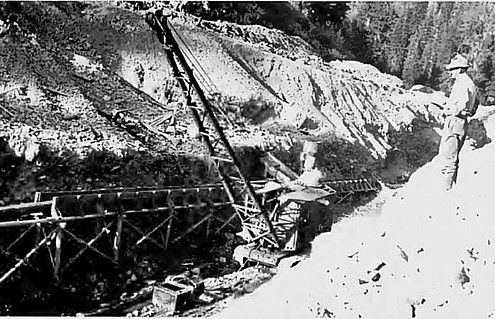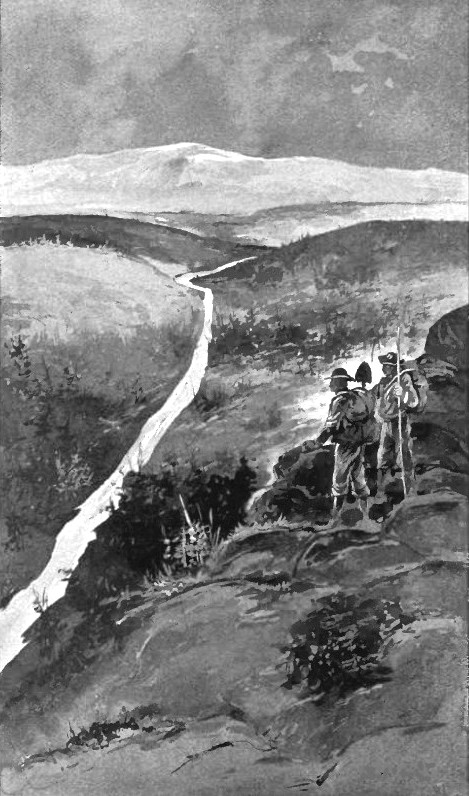This is part II of the
Commissioner of the US Land Office, US Department of the Interior:
It is undisputed that from one more than fifty thousand dollars' worth of
gold has been taken; from another more than forty thousand dollars, and
several have yielded from four thousand to twenty thousand dollars. Other
claims, where the aggregate yield is not stated, have produced from three to
ten dollars per day to the man employed in working the same. A number of
claims, shown by prospecting to contain gold, have yielded no return, and
the testimony shows that no attempt has been made to work them further than
required by the local laws for their "representation." It further appears
that, at the present time, none of the claims are being worked, except for
the purpose of sustaining the possessory title. I am led to believe that,
with perhaps a few exceptions, none of these claims can be worked with
profit until the owners can have unrestricted possession of the ground for
mining purposes. Ditches must be dug, and those already constructed kept
open for the passage of water; space must be had for the deposit of tailings
or refuse; and the surface of the ground must be unencumbered that it may
readily be removed, washed out and the gold extracted. All of these
conditions are Absolutely Incompatible with the existence of streets, alleys
and buildings, and hence the argument of counsel, that patent should issue
to both parties, the town-site and mineral applicants, if concurred in and
acted upon, would allow but one party to derive advantage from the grant. If
used for town-site purposes, it cannot be mineral. Prior to the 28th day of
February, 1877, The Entire Tract in controversy was included within the
limits of the Sioux Indian reservation, and all persons other than these
Indians, and certain agents of the Government, were forbidden by the law,
under severe penalties, from making settlement therein for any purpose
whatever. Notwithstanding this prohibition, the country was visited by
prospectors,
who discovered
gold, and reports of these discoveries led to a large influx
of population.
Placer claims were found on land now in controversy, and were worked for the gold they contained. These claims were staked off in accordance with local rules, and recorded, by which the character of the land was given the utmost notoriety. These locations were void and unlawful, and under them the locators gained no title whatever; yet they served the purpose of giving notice to all concerned of the character of the land. While portions of the claims were being worked for the gold they contained, other portions were rapidly occupied for various purposes, and at the ratification of the agreement with the Sioux Indians, quite a populous town had become established.
At this date, February 28th, 1877, the land was rendered subject to general occupation, and a lawful settlement might for the first time be made. Therefore, the occupation of the land by miner, merchant or any other person, was alike unlawful and prohibited under penalty provided by law; thereafter it might be occupied in accordance with law. Section 2318, Revised Statutes, reads: "In all cases lands valuable for minerals shall be reserved from sale, except as otherwise expressly directed by law." If the land was "valuable for minerals' as claimed, it could, under section 2318, only be lawfully claimed for Mining Purposes, and the fact that improvements had been made by persons acting at their peril, in direct violation of law, gave them no sort of color of right to retain possession of the same to the prejudice of others claiming in pursuance of law. If the land was non-mineral, no valid mining location could have been made upon it. The large population attracted to Deadwood by the mineral discoveries engaged in the various occupations called for in a mining camp. A municipal government was established, streets and alleys were laid out and many buildings, temporary and permanent, were erected. The operations of the miners soon clashed with these town improvements. Some of the mineral claimants made application for patents and entered their claims, and others were preparing to take the same steps to procure full titles to their lands, whereupon those claiming for town-site purposes petitioned the probate judge of Lawrence County to enter the land for town-site purposes, which he did.
The miners were then restrained in many instances from working their claims, sometimes by the road commissioner, and at others by warrants in the hands of the sheriff, and again by the citizens themselves, acting Without Color of Authority. Ditches were filled up, sluice-boxes and dams destroyed, and the miners themselves sometimes arrested and put under bonds to restrain from further injuring town improvements or those of private citizens. Though the miner was not actually evicted from his claim, he was only allowed the barren privilege of digging therein, but if without the power to construct ditches to bring and carry away water, such permission was without practical value. In short, Deadwood assumed the powers and privileges of a municipal government, unrestricted by United States laws, and in pursuance thereof its officers took ordinary measures and precautions to keep its thoroughfares open to public travel proceedings proper enough where the town authorities are entitled to jurisdiction, but otherwise when they would defeat rights guaranteed by United States laws.
It is the settled policy
of the Government to encourage the development of mines and the production
of the precious metals. The law makes every other claim to the public lands
subordinate to their occupancy and possession for mining purposes, and no
deviation from this policy is made in favor of town sites, the mining
interest being jealously protected where it permits lands overlying veins to
be patented for town-site purposes. In conclusion, I must hold that all of
the land claimed for mining purposes, as to which testimony was taken at the
hearing, is shown to be valuable for minerals. These claims are designated
as follows : Mineral lots (as designated by the surveyor-general) Numbers
38, 76, 72, 45, 53, 71, 78, 97, 109, 86, 83, 75 and 107; placer claims 13,
14 and 15 above discovery; and 16, 13 and 24 below discovery, Lost Mining
District; claims 16, 17, 18and 19 above discovery, Whitewood Mining
District; and claims 8, 9 and 10, on Whitewood Creek, in
north-east portion of the town site of Deadwood. Concerning the three claims
last named, I am unable to determine from the testimony and map submitted,
whether the same are situated in Lost or Whitewood Mining District. As to
the land lying outside of the placer
gold nugget claims, there is not sufficient testimony to
enable me to form an intelligent opinion as to its character. The Adjacent
Land having been shown to be valuable for minerals, strengthens the
presumption which heretofore obtained as to the whole tract, and this
outside land will still be regarded as mineral until the contrary be proved.
The only testimony offered at the hearing relating to this portion of the
town site was that of Mr. L. C. Miller, an insurance and mining broker, who
claims to be an experienced placer miner. He says that there are no mining
claims located outside of the gulches, and from the character of the ground,
it is well known that there is no pay in it. This, I must hold, is
insufficient to rebut the presumed mineral character of the land, supported,
as that presumption is, by the testimony which shows the adjoining" ground
to be valuable mineral land. A motion for a New Hearing as to this doubtful
portion will be entertained when the present town-site entry shall have been
finally disposed of. The town site of Ingleside is included within the
limits of Deadwood, and both entries must be held for cancellation. Give due
notice hereof to all parties in interest. Allow sixty days for appeal, and
thereafter report promptly to this office.
Very respectfully,
J. M. ARMSTRONG,
Acting Commissioner.
Return
to The South Dakota Page:
South Dakota Gold Rush History



